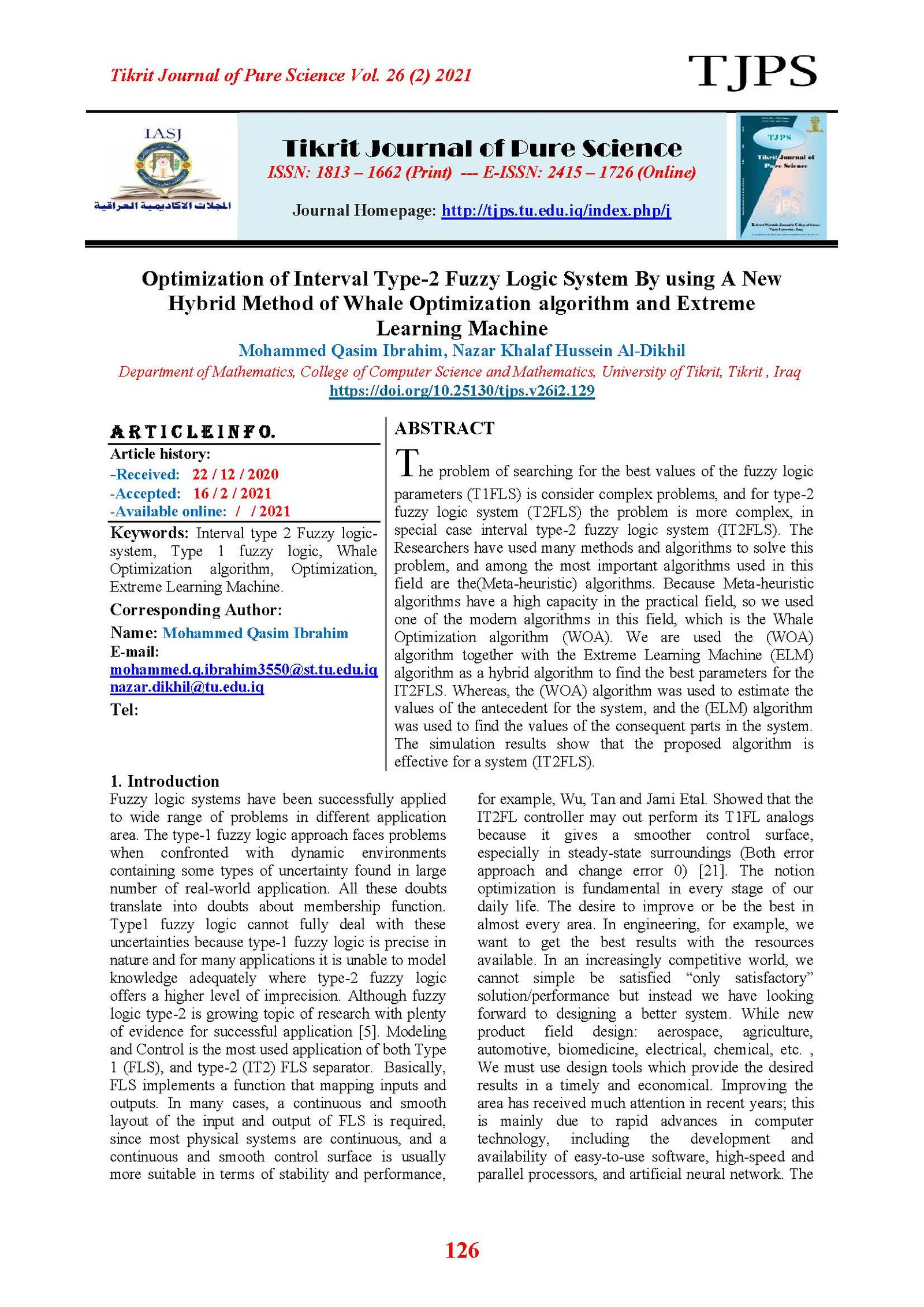Optimization of Interval Type-2 Fuzzy Logic System By using A New Hybrid Method of Whale Optimization algorithm and Extreme Learning Machine
Main Article Content
Abstract
The problem of searching for the best values of the fuzzy logic parameters (T1FLS) is consider complex problems, and for type-2 fuzzy logic system (T2FLS) the problem is more complex, in special case interval type-2 fuzzy logic system (IT2FLS). The Researchers have used many methods and algorithms to solve this problem, and among the most important algorithms used in this field are the)Meta-heuristic) algorithms. Because Meta-heuristic algorithms have a high capacity in the practical field, so we used one of the modern algorithms in this field, which is the Whale Optimization algorithm (WOA). We are used the (WOA) algorithm together with the Extreme Learning Machine (ELM) algorithm as a hybrid algorithm to find the best parameters for the IT2FLS. Whereas, the (WOA) algorithm was used to estimate the values of the antecedent for the system, and the (ELM) algorithm was used to find the values of the consequent parts in the system. The simulation results show that the proposed algorithm is effective for a system (IT2FLS).
Article Details

This work is licensed under a Creative Commons Attribution 4.0 International License.
Tikrit Journal of Pure Science is licensed under the Creative Commons Attribution 4.0 International License, which allows users to copy, create extracts, abstracts, and new works from the article, alter and revise the article, and make commercial use of the article (including reuse and/or resale of the article by commercial entities), provided the user gives appropriate credit (with a link to the formal publication through the relevant DOI), provides a link to the license, indicates if changes were made, and the licensor is not represented as endorsing the use made of the work. The authors hold the copyright for their published work on the Tikrit J. Pure Sci. website, while Tikrit J. Pure Sci. is responsible for appreciate citation of their work, which is released under CC-BY-4.0, enabling the unrestricted use, distribution, and reproduction of an article in any medium, provided that the original work is properly cited.
References
[1] Abiyev, R. H. and Kaynak, O. (2010). Type 2 fuzzy neural structure for identification and control of time-varying plants. IEEE Trans. Ind. Electron., 57 (12):4147–4159.
[2] Adhirai, S.; Mahapatra, R. P. and Singh, P. (2018). The Whale Optimization Algorithm and Its Implementation in MATLAB. Int. J. Comput. Inf. Eng., 12(10): 815–822.
[3] Aizenberg, I. and Moraga, C. (2007). Multilayer feed forward neural network based on multi-valued neurons (MLMVN) and a back propagation learning algorithm. Soft Comput., 11 (2): 169–183.
[4] ALing Q. and Mendel, J. M. (2000). Interval type-2 fuzzy logic systems: theory and design. IEEE Trans. Fuzzy Syst., 8 (5):535–550.
[5] Almaraashi, M.; John. R. and Coupland, S. (2012). Designing generalised type- 2 fuzzy logic systems using interval type-2 fuzzy logic systems and simulated annealing. 1st IEEE Int. Conf. Fuzzy Syst., 10-15 June 2012, Brisbane, Australia: p1-8.
[6] Almaraashi, M. and John, R. (2011). Tuning of type-2 fuzzy systems by simulated annealing to predict time series. 2nd Proc. World Congr. Eng., 6-8 July, 2011, London, U.K.: P 976-980.
[7] Bin Huang, G.; Zhu, Q. Y. and Siew, C. K. (2005). Extreme learning machine: Theory and applications. Neurocomputing, 70 (1-3):489–501.
[8] Eyoh, I.; . John, R. and De Maere, G. (2016). Interval type-2 intuitionistic fuzzy logic system for non-linear system prediction. 1st IEEE Int. Conf. on Syst., Man and Cybern. (SMC), 2016: p. 1063-1068.
[9] Eyoh, I.; John, R. and De Maere, G.(2017).Time series forecasting with interval type-2 intuitionistic fuzzy logic systems. 1st IEEE Int. Conf. Fuzzy Syst., May, 2017: p 1-6.
[10] Eyoh, I.; John, R.; De Maere, G. and Kayacan, E. (2018). Hybrid Learning for Interval Type-2 Intuitionistic Fuzzy Logic Systems as Applied to Identification and Prediction Problems. IEEE Trans. Fuzzy Syst., 26 (5):2672–2685.
[11] Huang, Y. and Lai D. (2012). Hidden Node Optimization for Extreme Learning Machine. 3rd AASRI Procedia Conf. on Modulling, Identification and Control, 2012, p. 375-380.
[12] Jang, J. -S.; R., Sun, C.-T. and Mizutani, E. (1997). Neuro-fuzzy and soft computing-a computational approach to learning and machine intelligence. Pearson Education Inc.:614pp.
[13] Kayacan, E.; Coupland, S.; John, R. and. Khanesar, M. A. (2017). Elliptic and membership functions the modeling uncertainty in type-2 fuzzy logic systems as applied to time series prediction. 1stIEEE International Conference on Fuzzy Systems, (FUZZ-IEEE), 2017: p 1–7.
[14] Khosravi, S., A.; Jaafar, J. and Khanesar, M. A.(2015). Hybrid model for the training of interval type-2fuzzy logic system. 1stInternational Conference on Neural Information Processing, 2015, p 644–653.
[15] Mendel, J. M. ( 2017). Uncertain Rule-Based Fuzzy Systems. 2nd edn., Springer International Publishing:684pp.
[16] Mendel, J. M.(2007). Type-2 fuzzy sets and systems: an overview. IEEE Comput. Intell. Mag., 2 (1):20–29.
[17] Mendel, J. M.; John, R. I. and Liu, F. (2006). Interval type-2 fuzzy logic systems made simple. IEEE Trans. fuzzy Syst., 14 (6):808–821.
[18] Mirjalili, S. and Lewis, A. (2016). The Whale Optimization Algorithm. Adv. Eng. Softw., 95 (2016): 51-67.
[19] Tung, S. W.; Quek,C. and Guan, C. (2009). T2-HyFIS-Yager: Type 2 hybrid neural fuzzy inference system realizing Yager inference. 1st IEEE Int. Conf. Fuzzy Syst., 20-24 August, 2009, Korea: p. 80-85.
[20] Wu, D. (2012). Twelve considerations in choosing between Gaussian and trapezoidal membership functions in interval type-2 fuzzy logic controllers. 1st IEEE Int. Conf. Fuzzy Syst., June 2012: p. 1-8.
[21] Wu, D. and Mendel, J. M. (2011).On the continuity of type-1 and interval type-2 fuzzy logic systems. IEEE Trans. Fuzzy Syst., 19 (1):179–192.
[22] Yu-ching, L. and Ching-hung, L. (2007).System Identification and Adaptive Filter Using a Novel Fuzzy Neuro System. Int. J. Comput. Cogn., 5 (1):1–12.
